10.13 Modern Culture
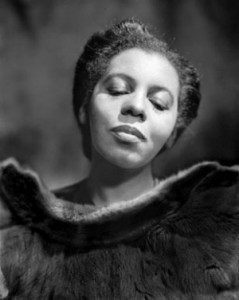
“Culture” is a concept both widely understood and impossible to define. When it comes to music, entertainments, the arts, and so on, the 20th century experienced a commodification of culture that alienated many of its forms from day-to-day practitioners. One of the great themes of sport history is the transition from “amateur” athletics (meaning top quality athletes who were sufficiently well off financially so they didn’t seek compensation for playing, running, rowing, or jumping) to “professional” athletics (originally a contemptuous term for men who were “paid to play” and later a term associated with the highest caliber of physical prowess). The same could be said of the arts generally in Canada. That is, they transitioned from an amateur phase to a professional one.
Historian of culture Maria Tippett has written of the late Victorian era as one that nurtured parlour-room musical performances, local art exhibitions, and thousands of church choirs of many denominations. Because most Anglo- and French-Canadians went to church every Sunday, it’s safe to say that they all either sang or heard singing in the company of others at least once a week. Tippett describes the Jarvis Street Baptist Church of Toronto, with its “250 voices” in the early 1890s, as the basis for the professional and semi-professional performance ensembles that emerged in the 20th century.[1]
Although we tend to understand high culture or high style as elite art forms associated with the upper classes and exemplified by opera, classical music and painting, and Shakespearean theatre, there is something of high culture in those church choirs, too. That is, the form, sound, meaning, and purpose — even the setting — of choral music was something that originated elsewhere, travelled around the world, was fairly rigid in that it wasn’t really locally modified (if at all), and was pretty much the same whether sung in Westminster or New Westminster, in Halifax, UK or Halifax, NS, in Paris or Parisville. Hymnal books provided a kind of corporate continuity within a denominational and ethnic context across the globe. What, then, of local culture? Where were its shoots likely to emerge?
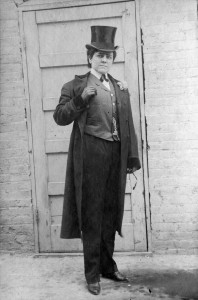
Canada’s Got Talent
Jonathan Vance, a leading historian of Canadian culture at the University of Western Ontario, has argued that the late 19th century witnessed the birth of a tension in Canadian society about cultural production. There was a hope that, in creating a nation-state, Canadian culture would emerge and flourish. When French-Canadians heard English-Canadians say “culture” they heard “assimilation.” The metaphorical ramparts around “Fortress Quebec” remained up as a consequence. What is more, ultramontanism gave pre-enlightenment European art a leg-up in Quebec, and European high-style was idealized. Meanwhile, in English Canada, the fetishizing of things British persisted. The schooling system in English Canada “celebrated British culture, idealized British history, and inculcated British values.” [2] And, of course, cultural growth in the expanding United States was producing an alternative and distinctive tradition of painters, sculptors, architects, writers, and even historians — any of which could be drawn upon by Canadian art buyers, governments, and readers.
Canadian artists, faced with these outward orientations, struggled to earn a crust. The idea of becoming a full-time creator of music or statuary, paintings, or magazines in Canada was fraught with problems. The safest path was to imitate the things that the Europeanists, Britophiles, and North American Continentalists admired and to avoid the pigeonholing of originality. These constraints were fundamental in holding back the growth of an indigenous English “Canadian” cultural form in the pre-1914 period. Similarly, the ultramontanist and conservative ideology of many Quebec cultural leaders reinforced a rejection of the secular modernist imagination and the kind of cultural experimentation that was going on in Paris. Quebec culture at the start of the 20th century was rooted in the experience of New France and distinct from that of post-Revolutionary France; it stood apart in many ways from Anglophone cultures, as much because of its aversion to modernism as for reasons of language and religion. Canadian talent was trapped in an imitative blind alley.
Vance points out, too, the legal environment in which art was produced in the Victorian era. Copyright laws in Canada did little to protect writers, whose works could be (and were) reproduced — pirated — by presses in the United States, Britain, and even by other Canadians. Cheap knock-off copies of three-cent popular fiction — the original “pulp” novels, so-named because they were made on low grade paper — out-competed the originals, which sold for much closer to a dollar. A struggling Canadian writer might be able to get into the Dominion market at seventy-five cents a copy but could not hope to attract the sort of sales and circulation that even reputable publisher/pirates could generate. Nor could such a writer survive on pennies a copy.[3] The establishment of tariffs on American publications did something to shore up publishers in wartime in particular, but Canadian presses struggled against both British and American novelists and poets who had strong markets at home. A Mark Twain, Victor Hugo, or H.G. Wells could saturate the market while a Sara Jeanette Duncan, Ralph Connor, or Lucy Maud Montgomery struggled to become recognized at home, let alone abroad. Not much would change in this regard for English-Canadian writers of fiction and non-fiction before the middle of the 20th century.
French-Canadian writers might have fared differently. There was an opportunity there to build on an early 19th century base and the histories of François-Xavier Garneau (1809-66), which predate Confederation, but the conservatism of the ultramontane establishment was powerful and effective in silencing modernist voices. Bishop Ignace Bourget (1799-1885) initiated in 1858 what would become a 30-year campaign to destroy the liberal-minded, anticlerical Institut Canadien (shuttered finally in 1885). What literature emerged in the early 20th century was rural-focused and idealized a pre-industrial Quebec or, perhaps more accurately, one in which industry was the exception. Although Montreal was the nation’s largest city, Quebec as a whole was more rural than urban until 1941, which explains the anti-urban focus in literature to some extent. Phillipe Panneton (1895-1960) wrote the novel Trente Arpents under the nom de plume “Ringuet” in 1938; the book was a landmark because it painted rural life as one of repeated challenges above which the protagonists could not necessarily rise, and as part of a world in which cities played a role. This was far from full-on modernist literature, but it broke out of Quebec with a 1940 translation, won a Governor-General’s Award, and thus constitutes an early contribution to the development of a national, pan-Canadian literature — some 70 years after Confederation.
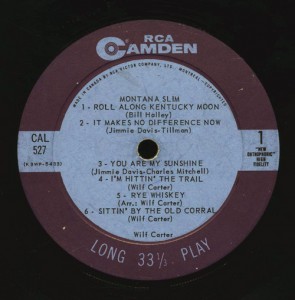
Modern Music
There are, of course, other avenues for artistic and cultural expression. The explosion of the folk art movement in the early 20th century — an expression of antimodernism — fed the growth of fiddle music in the Atlantic provinces and in Quebec and later the development of both country and western (originally and sometimes still distinguished by loyal fans).
Wilf (Montana Slim) Carter (1904-96) is a common thread joining both the Maritime and Western traditions. Born in Port Hilford, NS, he took up yodeling as a youth, left home at 15, and became an itinerant worker across the West, including a stint as a cowboy near Calgary. Singing while playing guitar — something of an innovation in its own right — Carter is responsible for the links between Swiss yodeling and C&W vocals. His first radio appearances in 1930 in Calgary were followed by a move to New York in the mid-1930s where he polished the singing cowboy routine. Carter influenced his contemporaries — including fellow Nova Scotian, Clarence (Hank) Snow (1914-99) — and other country and western (C&W) figures like the Maritimer/vagabond Charles Thomas (Stompin’ Tom) Connors (1936-2013).
While these musical styles were rooted in vernacular forms that had, to some extent, developed locally in the Maritimes, they were also an expression of the globalization of entertainment. The yodeling, for example, was picked up from touring Swiss singers. And while performers like Snow and Carter were often antimodernist in their focus on the virtues of rural life, they built early- and mid-20th century careers around the modern technologies of radio, recording, and television. They also felt it necessary to move to the United States in order to achieve artistic success, a trend that would continue for generations (although in this respect, as in so many others, the nationalistic Connors stood apart — calling them out as “turncoat Canadians”).
Of all musical styles in the 20th century, no form is so associated with early modernism as jazz. Like folk/country, jazz begins as a kind of vernacular form, spreading rapidly from New Orleans across North America. (It is worth noting that early jazz contained elements of the French quadrille, and so is part of the legacy of New France.) The jazz phenomenon was aided and abetted by railways that hurried performers from one venue and town to the next. Vancouver’s Patricia Hotel, for example, was home in the early interwar years to African-American jazz pioneers Ferdinand (Jelly Roll) Morton (1890-1941) and Ada (Bricktop) Smith (1894-1984). Sustained by African-Canadian communities in Montreal, Vancouver, and Toronto, jazz cross-fertilized other styles, including the big bands of the era. Of these, the one that acquired the greatest fame and popularity is Guy Lombardo and His Royal Canadians, led by Gaetano (Guy) Lombardo (1902-77) of London, Ontario.
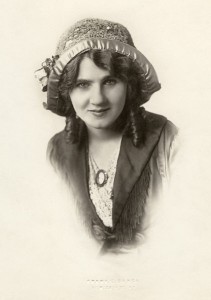
Stage and Screen
The music halls and vaudeville theatres of the early 20th century were made possible by rapid urbanization and, in return, were crucibles for talent and styles. Marie Dressler (1868-1934), Walter Huston (1883-1950), Florence Lawrence (ca.1890-1938), Mary Pickford (1892-1979), Raymond Burr (1917-93), and Yvonne de Carlo (1922-2007) all learned their craft on the music hall stage in Canada before heading to success in Hollywood. At the same time, a great many American and British actors (including Vincent Price, Jack Benny, and the Marx Brothers) honed their skills touring Canadian theatres on their way to what was now, in the 20th century, called “stardom.”
The dinner clubs and nightclubs of the major cities carried forward this tradition into the mid-20th century. As “entertainment” overtook culture and became an industry in its own right, there were plenty of what was called “marquee” talent or headliners whose musical or theatrical credentials were affirmed by appearances on live radio, in movies, and — beginning in the 1950s — television. Entertainment was rapidly becoming a fully integrated business and in every Canadian city (with the possible exception of Toronto), this was more fundamental to the cultural lives of a greater number than professional ice hockey. Canadian talent like bebop musicians Moe Koffman (1928-2001) and Fraser MacPherson (1928-93) were part of a generation that benefited from this multi-urban cultural ecology. Musicians had the further advantage of new recording technologies that took their performances beyond the stage and even beyond live radio into “canned” performances on the air or into the home with the diffusion of phonograph technology.
For the most part, these are examples of popular culture from the first half of the century. They were produced for urban audiences, people who earned wages for a living. The suggestion that these kinds of entertainment can be dismissed as escapist misses the point: they were meant to offer relief from lives of hard work, worry about finances, wartime anxieties, and a rapidly changing, modernizing world. They were meant to provide distraction and, yes, escape. If entertainments of this kind appear to us now, in retrospect, to be unsophisticated and stilted, it has to be remembered that the years from the 1890s to 1939 saw the appearance of mediums of communication and culture that had never before existed. These were years of unparalleled experimentation in music, film, and theatre that would set the tone for the rest of the century. The energy generated by this new populist era provides, as well, as stark contrast with the stagnation and limits of high style cultural practices like opera or the symphony — something that would generate increasing concerns by elites in the 1940s and ‘50s.
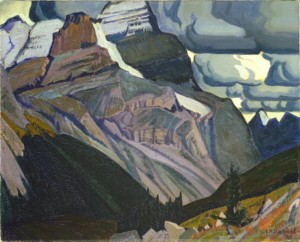
Visual Arts
If writing, music, and film-making in Canada were limited by the size of the audience before WWII, that was not the case for the fine arts. Some cultural productions will thrive in a marketplace dominated by wealthy patrons. Such was the case of the Algonquin School, also known as the Group of Seven. Lawren Harris (1885-1970) was heir to the Massey-Harris fortune (acquired in the production of agricultural implements and machinery) and capable of acting as patron to the Group while being an active and gifted member himself. The thrust of their philosophy was that the Canadian experience was intimately connected to the wild landscape and that the Group’s art, therefore, served a nationalistic purpose. The Group was 100% Anglo-Canadian and (despite the association of non-member Emily Carr) 100% male. Influenced by the Symbolist movement in Europe and some of the Expressionists, the Group of Seven’s output was sufficiently accessible — and the group so well connected that their work became representative of the modern art movement as a whole in Canada. Based in Toronto, the Group of Seven used their extensive social connections and their membership in the Arts and Letters Club of Toronto (effectively a posh clubhouse for artists, writers, and performers) to advance their interests. The Art Gallery of Ontario and the National Gallery in Ottawa were quick to stock up on their work, displaying it approvingly as the work of the nation’s leading artists.
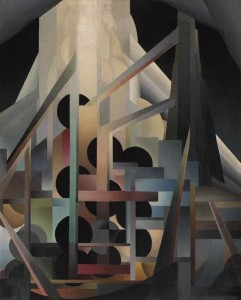
There were many artists who did not fit within the Group of Seven paradigm. Their contemporaries in Montreal, the Beaver Hall Group, was equally inclusive of women and men and more fully committed to a modernist and urban sensibility that did not echo the Group of Seven’s wilderness ideal of Canada. Abstract pioneers like Kathleen Munn (1887-1974) made connections with the Group but her outlook was simultaneously too modernist and too international for their appetites. Her friend and fellow abstract painter, Bertram Brooker (1888-1955) had his feet planted firmly in Canada, but also felt overshadowed by the Group, which he criticized in the 1930s as having become the very “orthodoxy” against which they had once railed. The Group came in for further criticism from artists in Montreal who rejected the nationalist aesthetic. The rival Eastern Group of Painters was established in the 1930s and one of its members, John Lyman (1886-1967), championed its successor group, the Contemporary Arts Society. These associations were, however, dominated by Anglophone artists. Further down the road of modernist techniques, it was Les Automatistes led by Paul-Émile Borduas (1905-60) who most fully embraced abstract styles and did so as a critique of what they regarded as the repressive political culture of Maurice Duplessis’ Quebec and the continuing influence of the Catholic Church on daily life in the province. The Automatistes issued a manifesto in 1948 that was explicitly anticlerical, anti-religious, and anti-establishment. This document, Le Refus global, remains a powerful example of the collision of modernist and antimodernist sentiment in the arts and in society and is sometimes cited as a catalyst in Quebec’s Quiet Revolution (discussed in Section 9.9).

Artists who were geographically, ethnically, or sexually on the margin of these central Canadian organizations worked largely in isolation, influenced by what was becoming the dominant style while developing their own. Of these artists, none is more deservedly well-known than Emily Carr (1871-1945), a British Columbian Post-Impressionist artist whose lush and flowing canvases are populated by Northwest Coast housepoles and towering cedars. While Tom Thomson’s Jack Pine and Harris’ Lake and Mountains are typical of a Group of Seven view in which people are conspicuous by their absence, Carr’s paintings document and celebrate the interplay between landscape and Aboriginal and contemporary societies. In her works, the environment is a place in which humans must — and do — find their way and be neither dwarfed nor dumbstruck by it.
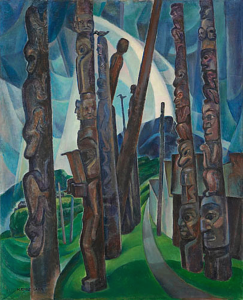
Key Points
- While high style cultural elements could be — and were — imported from abroad, Canadian artists struggled in the first hundred years after Confederation to be recognized.
- Those artists who neither imitated British, French, or American styles nor emigrated to make their careers in larger, foreign markets, were constrained by the structure of the publication and performance businesses in Canada, and a small and divided Canadian marketplace.
- French-Canadian writers in particular turned away from urban and modernist themes and therefore became too parochial for a national audience.
- Musicians also took up antimodernist themes that celebrated the vernacular cultures of rural Canada, although the most successful moved to the United States where opportunities were greater.
- The links between urban performance venues enabled the circulation of modern musical innovations like jazz and big bands, along with various stage performance styles.
- Painting was an area where a few wealthy patrons could take the place of a mass market audience. In that environment, artists associated with the Group of Seven thrived, producing a style that claimed to reflect the wilderness as the basis of a distinctive Canadian culture.
Attributions
Figure 10.20
Portia White by Yousuf Karsh is in the public domain.
Figure 10.21
Signed photograph by Daisy D’Avara of herself top-hatted in “A Contented Woman” (CVA 19-38) by City of Vancouver Archives is in the public domain.
Figure 10.22
Wilf Carter, Montana Slim – label, side 1 by Peter Zimmerman is used under a CC-BY 2.0 license.
Figure 10.23
Florence Lawrence02 1908 by Wisconsin Center for Film and Theatre Research is in the public domain.
Figure 10.24
Dark Autumn, Rocky Mountains – James MacDonald by J.E.H. MacDonald is in the public domain.
Figure 10.25
Bertram Brooker – Ascending Forms by Bertram Brooker is in the public domain.
Figure 10.26
Composition 11 Borduas by La Serviette is used under a CC-BY-SA 3.0 license.
Figure 10.27
Emily Carr 1928 Kitwancool by Emily Carr is in the public domain.

